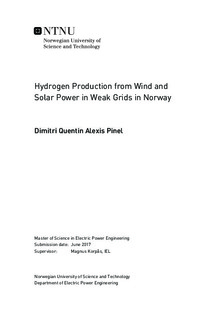Hydrogen Production from Wind and Solar Power in Weak Grids in Norway
Master thesis
Permanent lenke
http://hdl.handle.net/11250/2454362Utgivelsesdato
2017Metadata
Vis full innførselSamlinger
- Institutt for elkraftteknikk [2412]
Sammendrag
In this thesis, the possibility of implementing an hydrogen factory in the north of Norway was studied through the simulation of the system and an optimization of the needed investment with the exclusion of the grid and in the first scenario of 10% of the production coming from electrolysis. The same study was then repeated multiple times to study how the previous results changes if the proportion of hydrogen produced by electrolysis is increased. The necessary grid upgrade to avoid rationing was also found out. The main results were that the investment in wind power was mainly at bus 9 and 8 and that even if the electrolyzer size increased approximately linearly, the storage size on the other hand does not and increase greatly after the case 40%.
The possibility of investing in solar was then added to the model at a price of 3,8$/Wp and it turned out to not be profitable at this price before the case 50%. It was however found that the addition of solar power yields a positive impacts on the size of the storage needed due to advantageous seasonal effects.
The next step was to study different prices in order to find when solar becomes profitable. The resulting value for the case 10% was around 0.4$/Wp much lower than the current price of 1,6$/Wp but also reasonable in a longer term as suggested by some other studies. The next study was to account for the cost of the grid expansion in different cases to see if only limiting rationing is a good criteria. The simulation was used again with different grids and it appears that limiting the rationing was often giving the cheapest result even though upgrading the grid further do not result in a big increase in cost due to a trade off between operation cost and investment cost.
The last study was focused on the behaviour of the hydro system during the previous simulation cases and it highlighted some interesting seasonal effect of the different technology.
As of now, solar power does not appear to be a good solution for the case of 10% of the total hydrogen coming from electrolysis due to its cost. Wind power appears to be a preferable solution even if the investment is not large and thus does no take fully advantage of the resources of the north of Norway.
